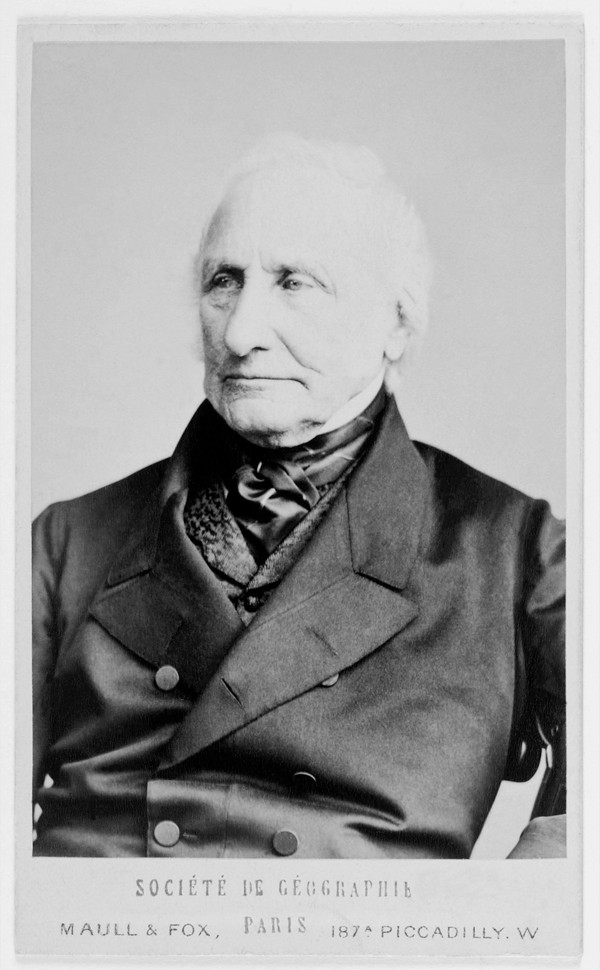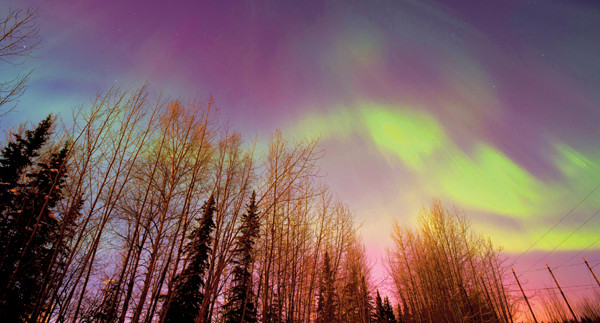
by Timothy Oleson Monday, May 12, 2014

Geophysicist and astronomer Edward Sabine (1788–1883). Credit: Bibliothèque Nationale de France, public domain
At the beginning of the 19th century, little was understood about Earth’s magnetic field, but interest in its workings had begun to grow, especially in Europe. That the magnetic field exists had long been recognized, and magnetic compasses had aided in navigation for centuries, particularly at sea where fixed landmarks are hard to come by. Not surprisingly, the increased attention emerging around the turn of the century came from naval and shipping interests, which recognized that an accurate understanding of the field’s behavior would be a boon to their fleets.
By this time, the underlying physical explanation for the magnetic field had also become a major source of scientific curiosity. In the preceding two centuries, observers had measured differences in the field’s intensity, inclination and declination — the angle between magnetic and true north — between locations, as well as changes in those properties at the same location, both over varying lengths of time. Others had noted the synchronized occurrence of colorful atmospheric auroras with widespread disturbances in the magnetic field, termed magnetic storms.
It was clear the planet’s magnetic field was an inconstant and complex phenomenon, and many eminent scientists saw it as the next great natural mystery to unravel. Although the 19th-century quest to explain geomagnetism would leave many questions unresolved, it greatly advanced knowledge of the subject. And beginning with Edward Sabine’s correlation of sunspots and geomagnetic disturbances in 1852, it also furthered our understanding of the interconnections between the sun and Earth.
Sabine was born in Dublin in 1788. His interests in observational science, and particularly in large-scale terrestrial and cosmic phenomena such as geomagnetics and astronomy, respectively, blossomed after his active combat duty in the British military ended in 1816. Although he never retired from the service, he was permitted to focus on scientific pursuits because of their relevance and potential benefit for the military.
Sabine took on the role of ship’s astronomer and scientist aboard a number of explorative expeditions beginning in 1818. That year, he was assigned to sail on John Ross’ voyage in search of the Northwest Passage, during which he regularly measured local magnetism, gravity, oceanographic and atmospheric properties, and documented wildlife wherever the ship went. From 1819 to 1820, he sailed with William Edward Parry on the first expedition to spend the winter in the Arctic, again collecting magnetic data and other measurements.
Additional voyages followed for Sabine in the next several years, during which time his continuing observations began to win him increasing credibility in the halls of prestigious scientific organizations such as the Royal Society and, after its founding in 1831, the British Association for the Advancement of Science.
In the mid-1820s, Sabine also began collaborating more with foreign scientists, as in 1825 when he was assigned with John Herschel to a joint British-French commission charged with determining the precise longitudinal difference between the Paris and Greenwich observatories. Such projects gained Sabine valuable connections and additional support for his own work, and opened his eyes to other European scientists’ research efforts and theories regarding geomagnetism.
This exposure, along with his own observations — which, though they had been collected all around the Atlantic Ocean over more than a decade by the end of the 1820s, were nonetheless sporadic — convinced Sabine that continuous worldwide observations were necessary to reveal the full extent and nature of Earth’s magnetism.
Driven by his belief in the need for a global dataset, and aided by his charisma and ample scientific and military connections, Sabine emerged in the 1830s at the head of a massive British endeavor to study terrestrial magnetism, which became known as the magnetic crusade. At the core of the crusade was a proposed network of geomagnetic observatories to be built in British colonies around the world.
Sabine first pitched the idea for the network, unsuccessfully, to the British government in 1835. But with backing for the idea from prominent scientists, the major British scientific societies and the military, the government finally approved the plan in 1839, allowing construction of geomagnetic observatories in Toronto, Canada; Hobarton (now Hobart), Tasmania; the Cape of Good Hope in South Africa; and the island of St. Helena in the South Atlantic.
With the stations starting operation in 1840, Sabine and the magnetic crusaders now had the means to amass the comprehensive worldwide magnetic dataset they sought. The new observatories, each with its own full-time staff, collected detailed hourly measurements of magnetic properties, reporting them back to headquarters at the Royal Military Academy in Woolwich, England, where Sabine oversaw the network’s observations.
By the 1840s, a number of theories, many of which overlapped, had begun to take shape to explain the magnetic field and its occasional disturbances. Scientists speculated on the number and behavior of magnetic poles and whether the field was influenced by (or that it itself influenced) meteorological, volcanic or other processes on Earth’s surface or interior. Others suspected an extraterrestrial origin, or at least contribution, to the field. These ideas were shaped in part by advancements in the understanding of the relationships between heat and electricity and between electricity and magnetism, such as Michael Faraday’s 1831 discovery of electromagnetic induction, by which varying magnetic fields create electric currents in conductive materials.
Sabine, who was less of a theoretician than some of his contemporaries, put most of his effort into collating and analyzing the tremendous amount of data coming out of the new British observatories. It was through such efforts of compilation, he believed, that the physical explanation for the magnetic field would be revealed. He published numerous papers reporting his dataset, characterizing the distribution of magnetism worldwide, and noting global trends — regular daily and monthly variations, for example — and apparent vicissitudes in its behavior.
In a January 1851 paper in the Philosophical Transactions of the Royal Society, Sabine summarized the data collected at the Toronto and Hobarton observatories from 1843 to 1845. In it, he counted departures, or disturbances, in magnetic declination from the average value at any given hour and showed a correlation between the number of disturbances coming out of the two vastly distant locations.
That same year, the prominent Prussian naturalist and explorer Alexander von Humboldt published a volume of his encyclopedic five-volume tome on the state of knowledge in the natural sciences, “Kosmos,” in which he mentioned observations of sunspots that had been made by Samuel Heinrich Schwabe in Germany. Schwabe, a pharmacist and amateur astronomer, had made daily counts of sunspots by telescope since 1826. He published his observations in 1838 and again in 1843, noting in the latter an apparent 10-year cycle in the appearance of sunspots, but his work received little notice, at least in the magnetic community, until Humboldt called attention to it.
After Sabine read Johann von Lamont’s 1851 publication noting a roughly 10-year periodicity in the amplitude of daily variations in magnetic declination, he decided to investigate the possible association between solar activity and the magnetic field. Such a link had been speculated on, but little effort had been made to study it, largely because of both the lack of knowledge about the sun’s emissions (solar flares, for example, would not be discovered until the 1859 Carrington Event) and the tools necessary to observe them. Neither Schwabe nor Lamont, in their own publications, had made the connection.
It did not take long for Sabine to do so. In March 1852, he submitted a follow-up to his paper from the year before in which he added observations of magnetic disturbances from 1846 to 1848 from the same two observatories. It was accepted for publication in Philosophical Transactions, and on May 6, Sabine read his paper to the Royal Society. The records from Toronto and Hobarton again matched each other, he noted. It was clear also that there were systematically more magnetic disturbances from 1846 to 1848 than in the earlier three-year period.
Comparing these records to Schwabe’s observations, Sabine remarked that it is “a most striking coincidence that the period, and the epochs of maxima and minima, which M. Schwabe has assigned to the variation of the solar spots, are absolutely identical with those which have been here assigned to the magnetic variations.” Specifically, he pointed out the apparent minimum in 1843 and maximum in 1848, and the apparent decennial cyclicity in each case. He went on to conclude, “it is quite conceivable that affections of the gaseous envelope of the sun, or causes occasioning those affections, may give rise to sensible magnetical effects at the surface of our planet.”

The synchronized appearance of auroras and disturbances in Earth's magnetic field was observed beginning in the 18th century, but scientists couldn't explain the connection. Credit: U.S. Department of Defense Joint Base Elmendorf-Richardson, Alaska/Public Affairs, Justin Connaher
In a 1994 article in Eos about the early years of solar-terrestrial physics, Air Force astronomer and historian E.W. Cliver wrote that Sabine’s finding was “the cause of great contemporary excitement,” noting, for example, an 1852 letter from Herschel to Faraday in which Herschel proclaimed: “If all this be not premature we stand on the verge of a vast cosmical discovery such as nothing hitherto imagined can compare with.”
Sabine’s observations were quickly confirmed by other scientists, including Rudolf Wolf in Switzerland, who refined the period of the sunspot and geomagnetic disturbance cycles to 11.1 years by gathering scattered sunspot data back to 1610. Otherwise, as Cliver writes, progress, and even acceptance, following Sabine’s announcement was slow to materialize. Sabine himself had pointed out in his paper that the actual physical mechanism by which the sun influenced the magnetic field remained unknown, and he continued making observations to help elucidate that mechanism into the 1870s.
Skepticism over the link between the sun and Earth, arising partly out of discrepancies between the timing of sunspots and magnetic disturbances on time scales less than a year, lasted through the 19th century and into the 20th century. However, as the ability to observe the sun and the understanding of solar physics slowly improved, doubt about the connection eroded. Observations of solar flares, the realization that the sun showers Earth with charged ions in the solar wind, and the recognition of the geodynamo as the main source of the planet’s magnetism aided acceptance.
Today, although many of the sun’s complexities still remain to be grasped, the 11-year solar cycle, driven by its own magnetic dynamo, is well documented. Scientists have come to understand that the sun’s periodicity modulates the total amount of solar radiation emitted; the frequency of sunspots, solar flares and coronal mass ejections; and the occurrence of auroras and magnetic disturbances — both predictable and unpredictable — here on Earth. With his identification of the corresponding sunspot and geomagnetic cycles, Edward Sabine opened the door to this understanding.
© 2008-2021. All rights reserved. Any copying, redistribution or retransmission of any of the contents of this service without the expressed written permission of the American Geosciences Institute is expressly prohibited. Click here for all copyright requests.